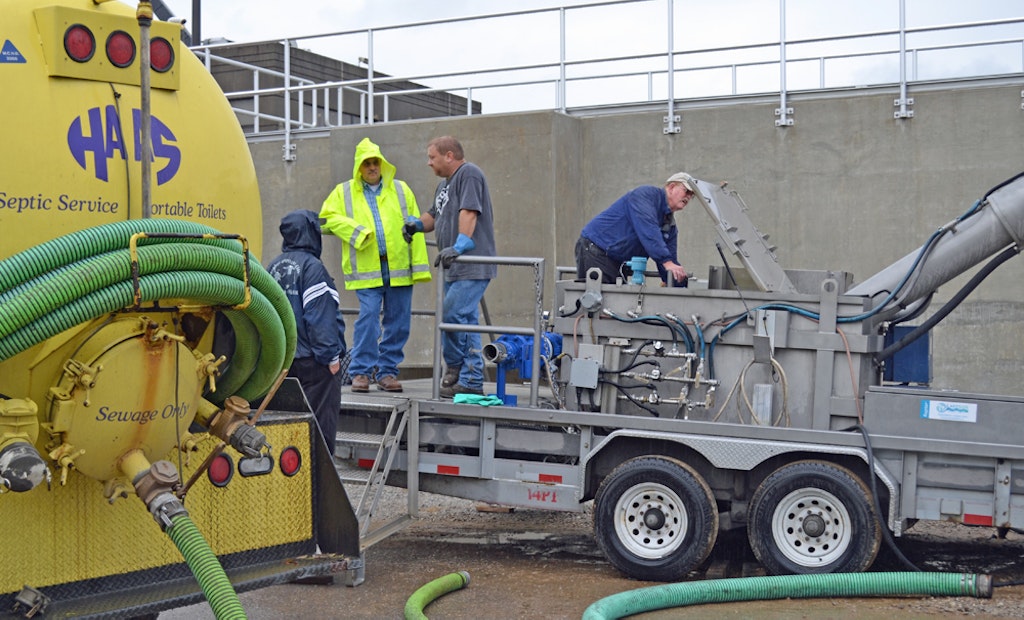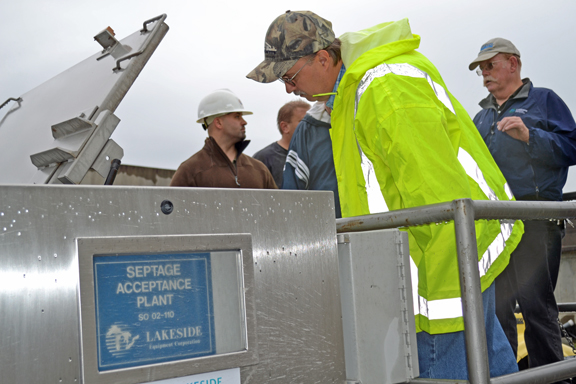
Interested in Disposal?
Get Disposal articles, news and videos right in your inbox! Sign up now.
Disposal + Get AlertsRising septage disposal costs and fewer land-application locations are two reasons the Marietta (Ohio) Wastewater Treatment Plant recently organized a septage acceptance plant demo. Local septage haulers were invited to provide input and suggestions on the unit.
Based on haulers’ comments and the city’s research, they are moving forward with purchasing and installing a permanent septage acceptance station. It will go out for bid to subcontractors by the end of 2014.
Plant and city personnel demonstrated a 400 gpm all-in-one mobile plant from Lakeside Equipment Corp. as a potential addition to an overall plant upgrade now in progress.
The Raptor septage acceptance plant removes debris and inorganic solids from municipal, industrial and septic tank sludge. The heavy-duty machine incorporates the Raptor fine screen and automatically dewaters and compacts the screened material.
“We’re renovating our treatment plant and looking at some added capacity,” says Steve Elliott, wastewater superintendent. “Here in Washington County there are no wastewater treatment facilities that currently accept septage so haulers land-apply. We’re looking at receiving and treating septage as a public service to get the septage out of the environment. It could be a source of additional revenue to the city, as well.”

City Engineer Joe Tucker says local septage haulers offered helpful recommendations to use the unit more effectively. “We wanted to get a lot of specific input, comments and suggestions from the haulers on their thoughts about using it and what important design features to consider.
“This is not what Steve and I do every day. It’s what these guys do on a daily basis.
“We got a lot of really great comments from the septage haulers. They suggested something as simple as a building with a restroom so they could use the bathroom and wash their hands while they’re unloading. It’s common sense when you think about it, but unless you build it into the design it doesn’t happen.
“One hauler mentioned elevation and suggested lowering the area where the unit is located so they can transfer via gravity. It’s not difficult to do at the early design stage.”
Tucker and Elliott reviewed all options for a septage acceptable unit by visiting several wastewater treatment facilities throughout the state. “We have been looking at the trends both statewide and nationally,” Tucker says. “We have traveled to other locations in Newark and Bowling Green to see how their facilities are set up, what kind of rates they charge and what kind of revenues are generated.
“This is supposed to be a 20-year plant upgrade so we’re looking into the future. We don’t think the EPA is going to continue to allow land application of septage, plus there are so many things that are non-biodegradable that get thrown in with septage, so you need screening. So we thought, why not buy the equipment that will take care of it and provide a service not only to our city but regionally in southeast Ohio, so haulers have a place they can bring their septage.”
Show me the money
Funding incentives for the entire plant upgrade are one reason Tucker and Elliott considered the septage acceptance unit.
“The Ohio EPA offers an incentive program for equipment designed to receive, treat and dispose of septage,” Tucker says. It covers installation costs for the unit through a reduction of interest rates on the city’s loan for the overall plant upgrade. “That’s a huge incentive.”
Revenue created from septage acceptance fees would go into a sanitary sewer fund. “There would a fee to local haulers, which is standard,” Elliott says.
Tucker says the additional revenue would help keep sewer rates reasonable for residents. “We’re definitely moving forward with design of a permanent location.”





